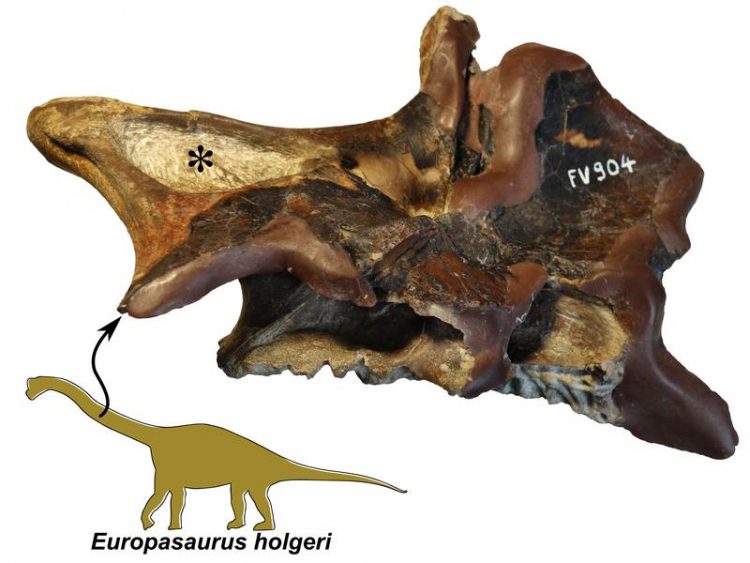Researchers show high-performance breathing in bones

Part of a neck vertebra of the dwarf sauropod Europasaurus with deep cavities (asterisk) that presumably housed air sacs. (c) Verändert nach Lambertz et al. (2018) Biol. Lett. doi:10.1098/rsbl.2017.0514
“The respiratory organs of vertebrates exhibit a tremendous degree of diversity, but the lung-air sac system of birds is truly unique among extant species,” says Dr. Markus Lambertz from the Institute for Zoology at the University of Bonn in Germany. Air sacs are bellows-like protrusions of the lung, and their volume changes cause the air flow in the separate gas exchanger. This functional separation is crucial for the exceptional efficiency of this respiratory system, but air sacs can do more: they can invade bones, a process called “pneumatization”.
Pneumatized bones are very light, because they are filled with air instead of the more heavy marrow, which was not only important for active flight, but also for the evolution of gigantism in sauropod dinosaurs. Through the presence of the resulting pneumatic cavities, it has long been known that air sac-like structures predate the origin of birds, since they were found both in the gigantic sauropods as well as in carnivorous dinosaurs. However, when and potentially how many times air sacs did evolve was inaccessible until now.
Pneumosteum: a hitherto unknown type of bony tissue as a diagnostic tool
Filippo Bertozzo was pretty surprised when he analyzed the bone structure in the course of his master’s thesis at the Steinmann-Institute for Geology, Mineralogy and Paleontology of the University of Bonn: “Bones that are in contact with air sacs exhibit a unique structure composed of very fine and densely packed fibers. After it turned out that this was true both in modern birds and extinct dinosaurs, we proposed to name this special kind of bony tissue “pneumosteum”.”
Especially astonishing was the fact that pneumosteum was not only restricted to pneumatized bones, but was also found on the surface of conspicuous cavities present in cervical vertebrae of sauropod dinosaurs. Dr. Lambertz adds: “Such cavities had already previously been hypothesized as potential locations of air sacs, but only our microscopic analysis now provides convincing arguments for this.”
Other soft tissues, such as muscles, can leave traces in bone as well. “There are several types of fibers within bone tissue, but the pneumosteum is markedly different from them,” explains Prof. Dr. Martin Sander from the Steinmann-Institute in Bonn. This characteristic individuality of the pneumosteum thus makes it an excellent diagnostic tool for recognizing bones that were in contact with air sacs.
Access to the past and potential for future research
Given that pneumosteum was only discovered in the dinosaurian lineage now provides the opportunity to trace the evolutionary origin of air sacs. Especially the fact that pneumosteum is not restricted to pneumatized bones but was also found on bone surfaces opens up access to studying species that might have exhibited air sacs as part of their respiratory system, but lack obviously pneumatized bones.
Fossilization of air sacs is nearly impossible because their delicate structure is composed of only a few layers of cells. Professor Sander thus is convinced that the discovery of pneumosteum will lead to a greatly improved understanding of the evolution of the dinosaurian respiratory system. Dr. Lambertz concludes with: „This project once again highlights the importance of the interdisciplinary collaboration between zoologists and paleontologists for elucidating evolutionary history.”
Publication: Lambertz M, Bertozzo F, Sander PM (2018) Bone histological correlates for air sacs and their implications for understanding the origin of the dinosaurian respiratory system. Biology Letters 14: 20170514. http://dx.doi.org/10.1098/rsbl.2017.0514
Contact for the media:
Dr. Markus Lambertz
Institut für Zoologie
Universität Bonn
Phone: +49228/735491
Email: lambertz@uni-bonn.de
Prof. Dr. Martin Sander
Steinmann-Institut für Geologie, Mineralogie und Paläontologie
Universität Bonn
Phone: +49228/733105
Email: martin.sander@uni-bonn.de
Media Contact
More Information:
http://www.uni-bonn.deAll latest news from the category: Earth Sciences
Earth Sciences (also referred to as Geosciences), which deals with basic issues surrounding our planet, plays a vital role in the area of energy and raw materials supply.
Earth Sciences comprises subjects such as geology, geography, geological informatics, paleontology, mineralogy, petrography, crystallography, geophysics, geodesy, glaciology, cartography, photogrammetry, meteorology and seismology, early-warning systems, earthquake research and polar research.
Newest articles

Innovative vortex beam technology
…unleashes ultra-secure, high-capacity data transmission. Scientists have developed a breakthrough optical technology that could dramatically enhance the capacity and security of data transmission (Fig. 1). By utilizing a new type…

Tiny dancers: Scientists synchronise bacterial motion
Researchers at TU Delft have discovered that E. coli bacteria can synchronise their movements, creating order in seemingly random biological systems. By trapping individual bacteria in micro-engineered circular cavities and…

Primary investigation on ram-rotor detonation engine
Detonation is a supersonic combustion wave, characterized by a shock wave driven by the energy release from closely coupled chemical reactions. It is a typical form of pressure gain combustion,…



